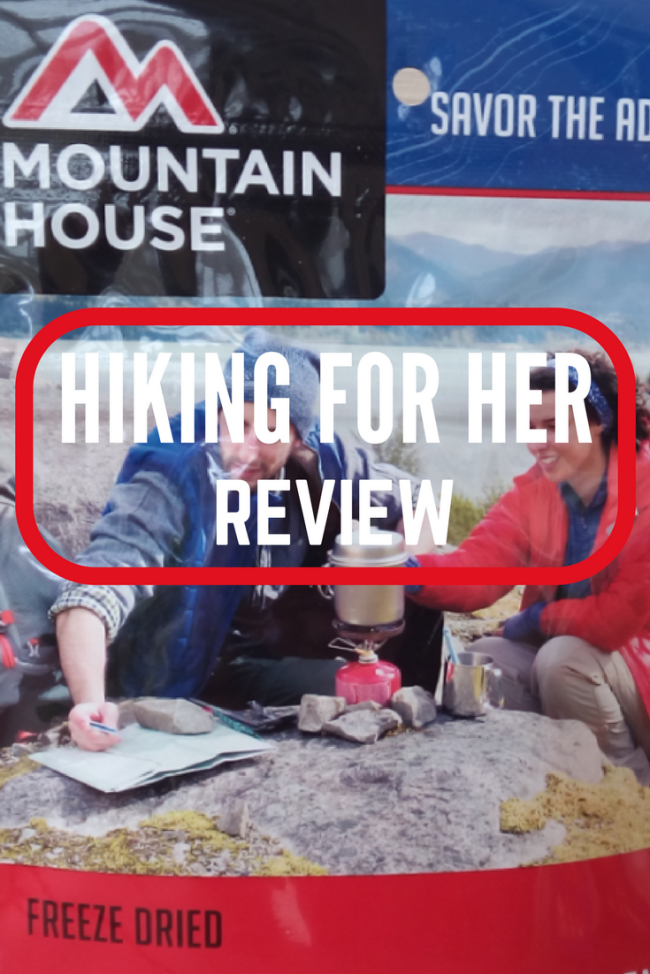
Mountain House Review:
Freeze Dried Meals For Hikers And Campers
By Diane Spicer
This Mountain House review gives you plenty of details on what Mountain House freeze dried food can add (or not) to the enjoyment of your next backpacking or car camping trip.
- We'll take a close look at the aspects of freeze dried food that really matter when you're tired and hungry after a long day on the trail.
- We will also look at a few Mountain House meals through a nutritional lens to see if they deliver the nutrients you need.
Mountain House review disclosures
First, let's establish the fact that I've been eating Mountain House freeze dried food since the 1970's, when the company first got started.
Unbelievable, you may be murmuring.
And in fact, it's unbelievable to me as well! For two reasons:
- Hard to believe that I've grown into a "well seasoned" (small food pun) hiker, with over five decades of hiking under my boots.
- Also hard to believe that this company has hung in there over the decades to dominate the freeze dried food market. There must be reasons, right? (Keep reading.)
Another thing you need to know is that if you read this Mountain House review and decide to purchase some for your next hiking trip, you can use this link to explore your options.
- Hiking For Her will receive a small percentage of your purchase price.
- It costs you nothing extra, yet it keeps the free hiking tips flowing on this website.
A fair question in this Mountain House review of freeze dried food
Does this affiliate relationship mean that I'll say only nice things about Mountain House?
- Judge for yourself by reading the review ;)
Hiking For Her has one purpose for doing unpaid reviews: to get the best outdoor products into your hands.
That includes providing my opinion of drawbacks, right along with the benefits, of bringing Mountain House on your next outdoor adventure.
A few more disclosures to set the scene
The freeze dried hiking food which was tested for this review includes:
- Chicken Fajita Bowl (seasoned grilled chicken, rice, fire roasted vegetables, and black beans)
- Mexican Style Rice and Chicken (with tomato, peppers & olives)
- Fire Roasted Vegetable Blend (bell peppers, onions, corn and black beans)
Notice a theme here?
Clearly, Hiking For Her has a distinct bias toward chicken and vegetables.
Also to keep in mind: companies rotate their offerings constantly. What is covered in this review might not be available when you're ready to shop. But the basic findings of this freeze dried backpacking food review remain the same.
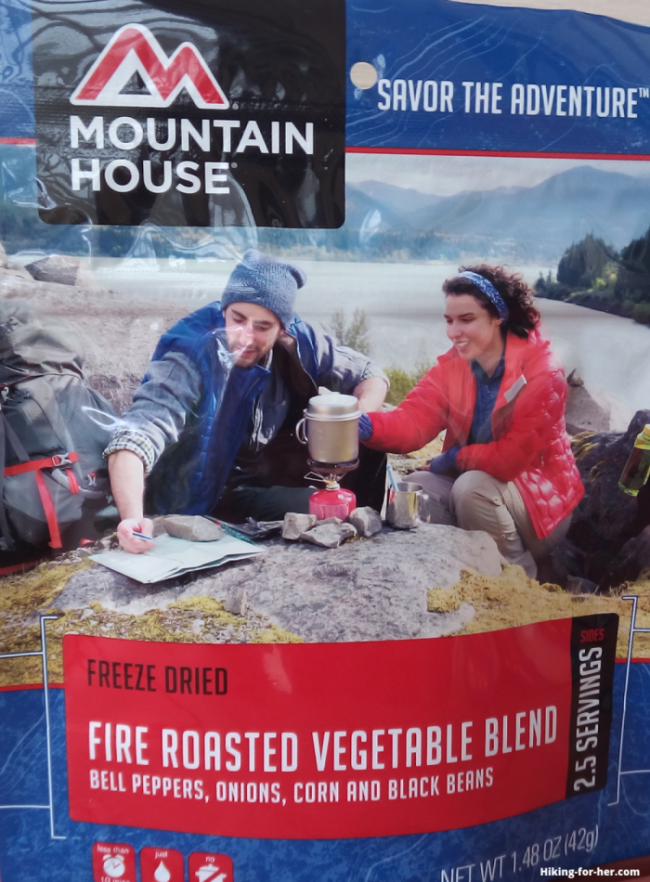
More disclosure about food preferences:
I like spicy food, I crave salt like a crazed porcupine after a long hike, and I love to crawl into my sleeping bag with a full stomach at the end of the day.
Because of some disappointments in the past, I never take a new freeze dried meal into the backcountry without trying it at home first.
- Which explains why this Mountain House review was conducted in my home kitchen, not on an outdoor stove.
- Luckily, only boiling water and some patience is required, regardless of where you eat your Mountain House.
Now that I've set your expectations, let's get to the good stuff in this Mountain House review!
Mountain House review:
taste and ease of preparation
First things first, right?
Mud encrusted boots and socks are off, tent is set up, and the camp stove is fired up to boil water for the evening meal.
You're anticipating a hot meal before turning in for the night.
You want your food to be satisfying, flavorful and filling.
You don't want your food to take a long time to prepare, or to cause digestive upsets.
So are these entrées going to deliver?
Yes, definitely.
But let's be clear about a few things in this Mountain House review.
Taste and flavor
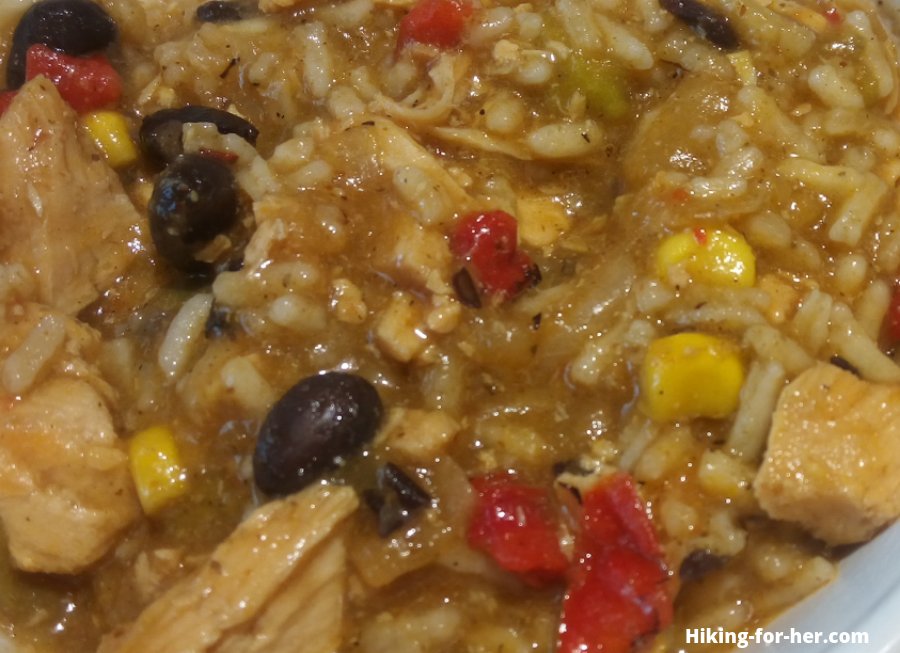
Uh, what's the difference?
Here's how I use those terms.
Taste refers to which taste buds on my tongue perk up when I bring the food into my mouth.
- There are sweet, bitter, salty, sour and umami tastes.
Flavor, on the other hand, is where things get more subjective.
To name a few issues which can "flavor" your perception of flavor:
- your food associations with past meals (including childhood)
- the lingering dominant tastes on your palate
- the mouth feel of the food
Saltiness rating
The taste of this Mountain House food was surprising light on the salty end of things.
I say "surprising" because my memories of Mountain House from decades gone by definitely included "salty" as a dominant characteristic.
We'll talk about the sodium content of this food later, but keep in mind that sodium can be a hiker's friend after a sweaty hike.
More taste-y tidbits
in this Mountain House review
It would be surprising to experience strongly sweet, bitter and sour tastes in a backpacking dinner meal, and I'm happy to report there were no surprises in these food pouches.
Umami, defined sometimes as the savory-ness of food, is a tougher nut to crack.
This flavor experience has a lot of interesting chemistry behind it (glutamates, for instance).
So it's not surprising to find that flavorings and enhancements are added to the ingredient list of freeze dried meals to up the umami quotient.
- These additives increase the odds that you will fully savor the flavor of your hard earned meal in the backcountry.
- It's definitely better than chewing flavorless rehydrated meat, we can all agree on that.
Another way to approach the umami side of things:
Read the ingredient list and choose meals with whatever says savory to you.
- The Mexican Style Chicken and Rice I sampled for this Mountain House review would be a great choice, given its inclusion of jalapeño pepper, garlic, red pepper and other spices to create a savory sauce.
Tip to maximize your flavor experience
Now that you've hauled your Mountain House foil packets up to your "mountain house" (or lake side, or wherever you're camped for the night), you want your taste buds to be impressed.
But your perception of flavor also relies upon the aroma (odor) of the food.
After a long, dusty sweat-fest on the trail, it's likely that your nasal passages are dried out.
- So drink plenty of water before you eat, to give both your taste buds and your sense of smell (both are water based senses) enough hydration to appreciate your food.
What's mine isn't yours
Now a word of caution as you read this Mountain House review.
Each of us has personal definitions of "tasty" and "flavorful".
And we all have our own tolerance levels and cravings for saltiness, herbs, and spiciness.
So when I rate these meals as on the milder side, recall that I love to kick up the heat in my hiking food.
- Carry some hot sauce and cayenne pepper powder, if you agree.
However, I would rate these chicken entrées as flavorful, in the sense that I could smell the chili and garlic powders when I opened the pouch as well as when the food was on my spork.
And I could see that the food was coated with these seasonings, making my anticipation and salivation levels quite high.
See what I mean?
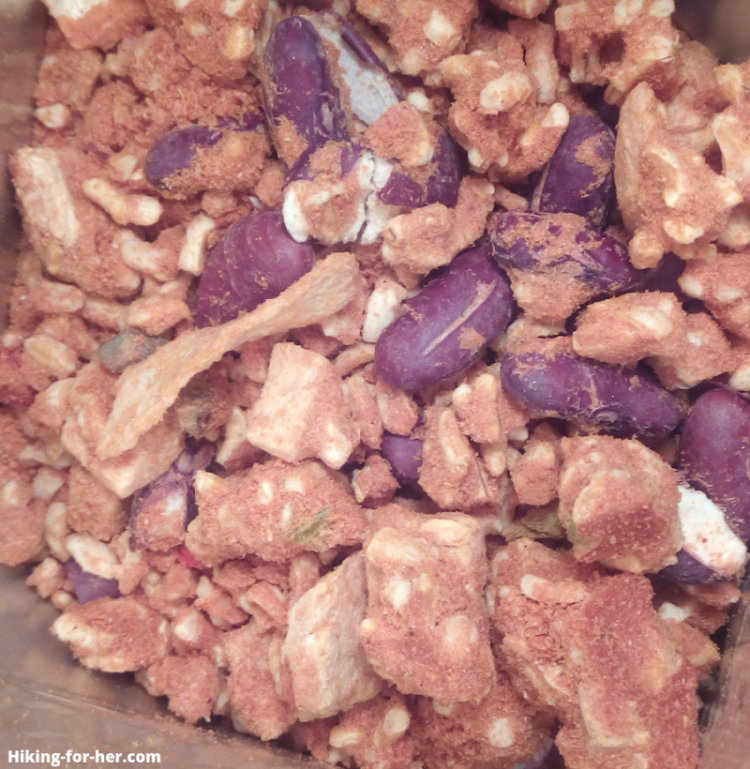
And from the Mountain House perspective, it makes sense to make milder food and allow folks to doctor it up according to personal preference, right?
- Creates a lot of versatility for us hikers!
A note on the phrase "natural flavors"
The process of freeze drying food (dessication) takes away the flavor.
Nothing to be done about it, except to add back some of the flavor at the end of the process.
That's why you'll see "natural flavors" listed as an ingredient.
Natural flavors by law can include chemicals and source materials that might raise your eyebrows.
Two things to note:
- The amount used in your entrée is small in comparison to the amount of food you are ingesting.
- You don't eat this type of food every day, so your body's organs of elimination are more than ready to handle those flavorings.
Portions of backpacking food matter to hikers
On a backpacking trip, I turn into a food monster.
All I can think about is eating the next snack or meal.
So I caution you to build in some wiggle room around the recommended portion size of any freeze dried food (which are based on the caloric requirements of a sedentary person, not you on a backpacking trip).
Mountain House agrees!
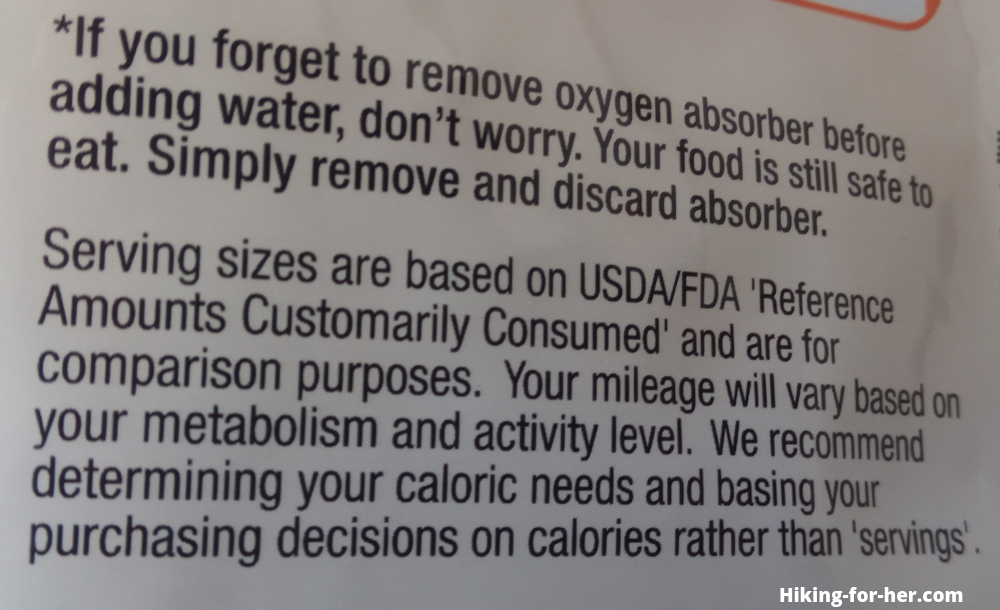
Small side note in this Mountain House review
Nice to know that if you warm up the small packet of oxygen absorbing material along with your meal, you can still eat it!
- If you've ever had a debate with yourself about this, and decided to eat the whole dang thing anyway, you'll be chuckling right now.
Bulk it up a bit
If you're concerned about feeling hungry after your evening meal, here's what I do.
I rehydrate some veggies and add them to my main entrée.
Why not eat them side by side?
You'd have to carry an extra bowl or cup, because fishing those slippery veggies out of the pouch isn't easy when you're hungry.
- Just dump them into your main pouch, and enjoy!
Note: The fire roasted flavor in my Mountain House review veggie choice is quite noticeable (in a good way), so be sure you want to experience it in your meal.
There are more tips below about how to create the sensation of satiety ("a full stomach") after you eat, so keep going.
Nutrient levels in these Mountain House options
Let's take a hard look at sodium in the two chicken meals I ate for this Mountain House review.
I was surprised to note they provided only 23 - 29% of the recommended daily value for sodium (for sedentary people, not hikers).
Here's my take on this.
At home, it's important to avoid overly salted food because of the long term health implications.
On the hiking trail, you need that salt for normal electrical activity in your cells.
So you might find that you want to add salt to these meals if you've got a big salt craving.
- This is not health advice. It's just a tip to pay attention to your food cravings, and work with them as much as you can on a lengthy backpacking trip.
Tip: Put together a small, lightweight seasoning kit which includes your favorite spices and salts, and play chef right there in your meal pouch.
On the other hand, if you're not sweating hard, having less salty food is a good thing, right?
- You won't have to drink extra water to satisfy your thirst, for one thing.
Calories
At first glance, the calories per serving look really low for a hard working hiking body:
- 220 or 280, depending on which chicken entrée you choose.
Here's the kicker: It's really easy to eat the entire package of a Mountain House dinner, which is labelled as 2 servings.
So double that calorie amount, and you're in a range that makes more sense for backpackers.
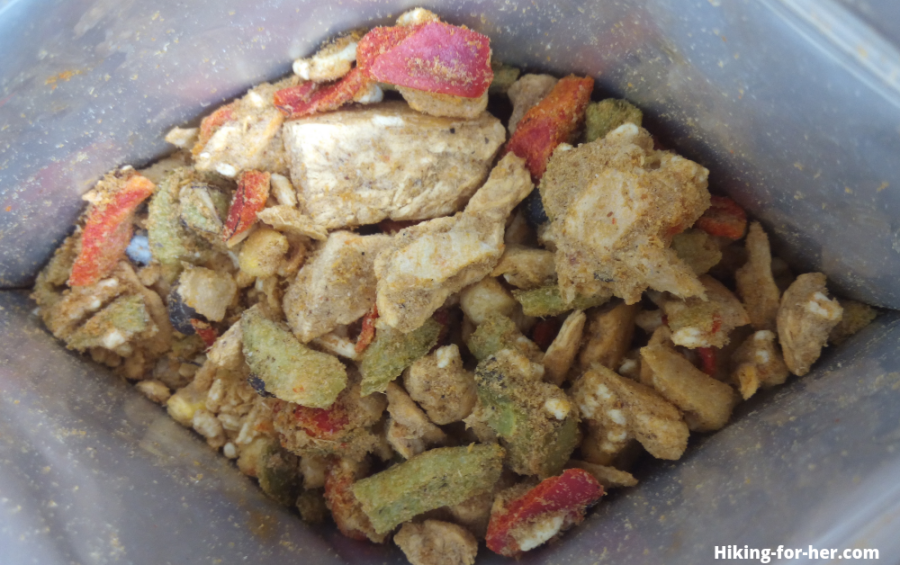 Chicken chunks and beans provide "replacement parts" (amino acids) for your sore, tired muscles while you sleep and digest your evening meal.
Chicken chunks and beans provide "replacement parts" (amino acids) for your sore, tired muscles while you sleep and digest your evening meal.
Carbohydrates, protein and fat
During a hike, carbohydrates are my best friend to keep my body fueled up and humming along.
At an evening meal, they become less important so I turn my attention to the amount of protein and fat my dinner is providing.
The amount of those nutrients in this selection of Mountain House review meals was on the low side, in my opinion.
- This opinion applies only to high activity levels, like double digit mileage with a heavy backpack.
- If you're not working super hard, the amounts may be adequate to fuel your activities.
- You can also investigate beef entrees for comparing protein amounts with these chicken meals.
To be sure I'm getting all that I need, I could add two things to these entrees:
- A shot of high quality olive oil, to increase the unsaturated fat which my cell membranes need, and to create the feeling of satisfaction after a meal
- Quinoa, which provides an amazing amount of protein for such a lightweight grain
Need more data?
If you'd like to estimate your caloric and nutrient needs with precision, my Fast Facts booklets can help with that.
- Take a look here.
A note about vitamins
While I don't fret too much about vitamin intake during a short backpacking trip, there is one that I pay attention to when I'm gone for more than a few days: anti-oxidant, water soluble Vitamin C.
The percentage of daily values of vitamin C in the food discussed in this Mountain House review was highly variable:
- 100% in the vegetable blend
- 80% in the fajitas entrée
- 2% in the rice & chicken meal
As a precaution if you're a believer in regular vitamin usage, bring some powdered vitamin C to add to your meals so your daily intake evens out.
- Lots more ways to get Vitamin C on a backpacking trip here.
The indisputable convenience of Mountain House
One of my favorite things to do when I plot my next backpacking adventure is to stand in front of the rows of freeze dried food at my favorite outdoor gear store.
Mountain House is front and center, tempting my imagination with creative descriptions and tasty ingredients.
While freeze dried backpacking and camping food isn't necessarily the cheapest way to go, it's definitely a time saver.
- I'd rather invest my time in inspecting my gear, going over my gear list one last time, and double checking my maps.
I probably shouldn't confess the shocking extent of my laziness, but I've been known to rehydrate a Mountain House entrée at home after a long day of gardening or house chores.
- Why cook, when Mountain House did it for me?
Another nice thing to note in this Mountain House review: When you return home with a few extra pouches, the long shelf life means you'll be able to use it next time.
If you live in an area where natural disasters occur, knowing you have some packets of Mountain House stashed away is a reassuring thought, too.
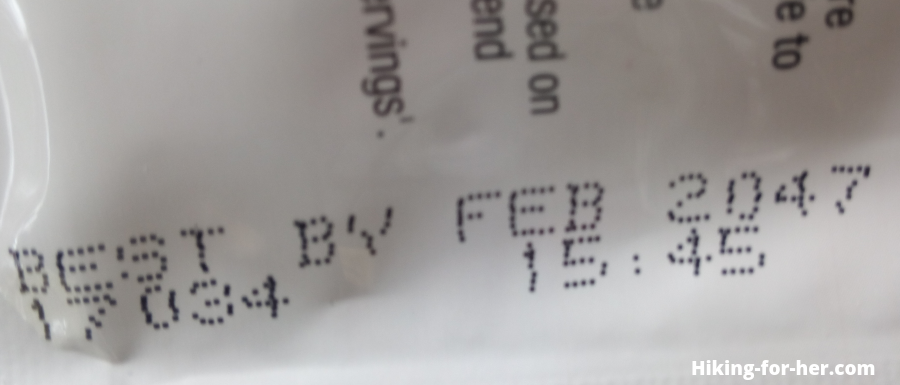
A few tips for using this food
This Mountain House review would be incomplete without a few tips on how to use this food as a vital component of your outdoors adventures.
Amount of water to use
Water in, water out on a hiking trail.
If you've had a fairly easy day in mild conditions, you didn't lose a lot of electrolytes and water via sweat or open mouth breathing.
On the other hand, a brutal day of elevation gain under the broiling sun translates into the need to replenish your water balance.
Here's the tip: Add at least 1/4 cup of extra water to the package.
- Expect a slightly soupy consistency, but that's exactly what you're going for.
Hydration time
It's hard to wait for water to boil when your stomach is cramping from hunger, but discipline yourself to do it.
- Luke warm water is not going to create the desired culinary experience inside that foil pouch.
Also use a little tough love on yourself as you count down the minutes until you can eat.
Why?
Hard, crunchy black beans in your Chicken Fajita dinner are not your digestive friends four hours later when you're inside your warm, cozy sleeping bag.
- Or your tent mate's friend, if you take my meaning.
Tip: Rig your campsite so you leave a few minor chores that you can do while your food is getting plump and juicy.
Anything to engage your brain and distract your stomach for 8 or 9 minutes works!
True story: Time slows down to a crawl when you're watching a Mountain House pouch.
So don't look!
You will skip the whole irritating "Is it time yet???" scenario and come back to a warm pouch filled with goodness.
Waiting for a bit before digging into your backpacking dinner also makes good biological sense.
- The first phase of digestion involves your brain, so by waiting and anticipating your food, you're setting yourself up for a good digestive experience.
Another tip: The foil package makes a handy hand warmer as you're waiting, if you can't tear yourself away from your food.
Skip the dishes
Eat this backpacking food right out of the pouch you used to prepare it.
You'll need this long handled spork, though.
Do your trash duty
Carry a dedicated heavy duty, re-sealable plastic bag of whatever dimensions make sense for the length of your backpacking trip.
That's where your used foil pouches and other dinner prep trash should be stored.
In bear country, this plastic bag should remain in one place: inside a bear resistant container.
If you accidentally slop food on the ground, after you mourn the loss you need to scoop it up to avoid critters.
- Use a scooper that can either be thrown into the garbage bag along with the food (like a piece of tree bark) or can be made odorless with soap (an extra spork).
In country which hasn't seen a bear in decades, it's the rodent population you need to worry about.
- Take precautions such as hanging your garbage bag or using chew-resistant bags.
Leaving trash and odiferous items in your backpack is just an open invitation to the neighbors to join you for a snack.
Think food is safe from rodents in your tent?
Think again!
I once had a persistent mouse chew through the mesh tent door and then chew through my thick backpack pocket to reach a few forgotten peanuts, while I slept peacefully.
- Lesson learned: two gear repairs, but admiration for the powerful jaws of a tiny mouse.
Mountain House review conclusions
This company has been providing food for all types of outdoor enthusiasts for a long time.
Mountain House knows how to turn heavy, water laden food into lightweight, easy to prepare, tasty options for backpackers and campers.
Because of my long history with their products, I must add that I've noted a steady improvement in the Mountain House experience, especially within the past 5 years or so.
Their selection of hiking menu options is impressive, and it won't take you long to find some entrées to enjoy on your next adventure.
The ingredient list clearly informs you of any food groups that you might need to avoid for medical reasons.
- For example, the Mexican Style Rice & Chicken is labelled as containing milk and soy, but is gluten free.
Their tough but lightweight foil packaging stands up to being thrown into a pack, and stands on its own on uneven surfaces at a rugged camping spot.
Here’s the true test
Would I eat this entrée, even if I didn’t have to?
For instance, on car camping trips when I have access to a cooler?
- Yes, I would choose these entrées.
- And then put a personal spin on them to adjust for my taste, flavor, caloric and nutrient needs.
That says it all, don't you think?
Mountain House review: your questions
Thanks for reading this Mountain House review.
It was a lot of fun to revisit a brand that has shared many trail miles with Hiking For Her!
Contact me with your questions about anything I've mentioned in this Mountain House review, and I'll get right back to you (unless I'm hiking, but I know you'll understand the delay).
Now it's time to build your own personalized camping or backpacking menu!
Home page > Hiking Nutrition >
Mountain House Review
|
I get emails all the time about what I wear, eat, carry and love to use on the trail. That's
why I provide affiliate links to you: the best gear that I use myself and have seen used by other hikers is instantly
available for your consideration, and the gear company sends a few
pennies per dollar to this reader-supported hiking website. There is no added cost to you! Everyone ends up a winner: Great gear for you, strong gear companies, and more free hiking tips for everyone. Thanks very much for your support. It's warmly and sincerely appreciated. It also helps send these hiking tips to all your virtual trail buddies around the globe. |
 |
